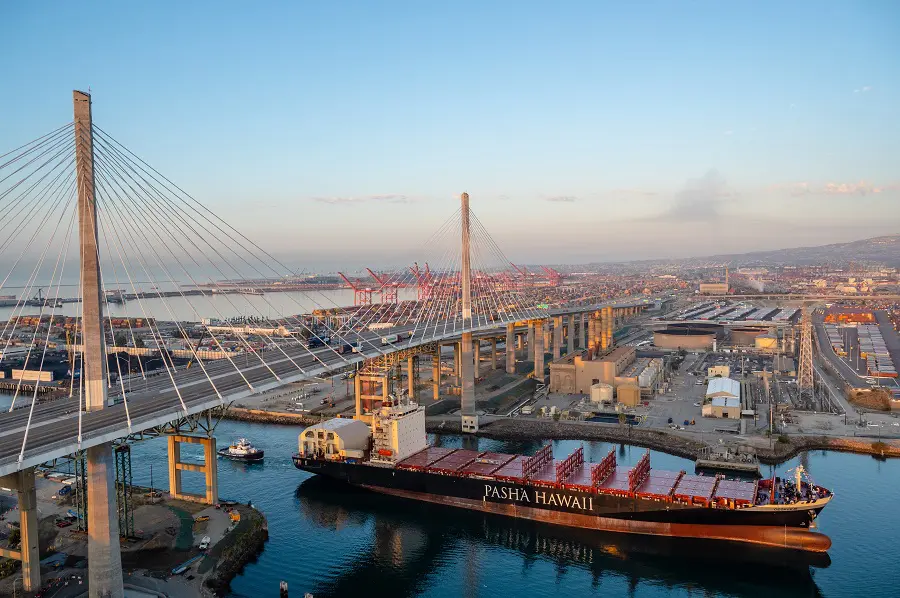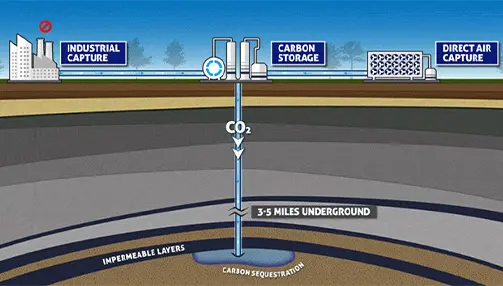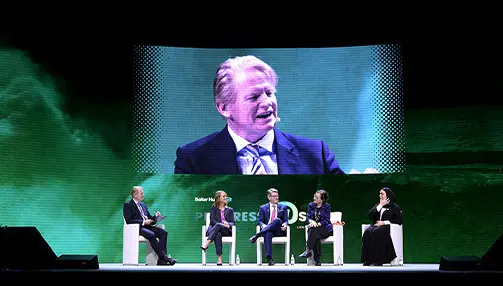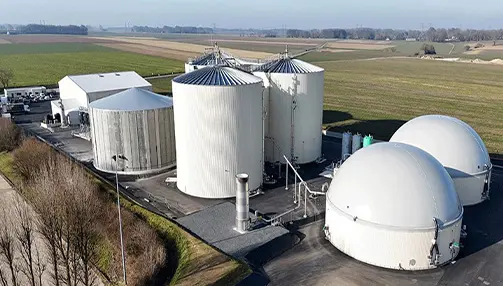
Hawaii Says Aloha To LNG

On August 25, Pasha Hawaii announced the arrival of Hawaii’s first liquefied natural gas (LNG)-fueled container ship, the MV George III. The ship marks the first of three Ohana Class vessels. The second ship, the Janet Marie, is expected to debut in late 2022, while a third Ohana Class vessel is forecasted to be deployed in mid-2023. The MV George III is scheduled to bunker every second week at the Port of Long Beach as it transports goods between Hawaii and California. Honolulu serves as the home port for the MV George III.
George Pasha III was Pasha Hawaii’s President and CEO, George Pasha IV’s, late father. “My father was the epitome of a true entrepreneur, whose aloha for the Islands guided him into building a company focused on serving the people of Hawaii,” said George Pasha IV. “He wanted to make a difference in the lives of those who call Hawaii home, by ensuring Hawaii’s businesses had what they needed to provide for their customers. Designing a ship in his name that would set the bar in environmental sustainability for future ship building was a must. Hawaii is a special place with natural resources that need to be protected. I think my father would be proud of what we were able to accomplish.”
Pasha Hawaii provided an initial US$20,000 donation to the Hawaiian Legacy Reforestation Initiative (HLRI) as part of a carbon offset partnership. Pasha Hawaii’s pure car truck carrier, the MV Jean Anne (named after George Pasha IV’s mother) transports personal owned vehicles (POVs) to Hawaii. Pasha Hawaii will make donations to HLRI for every POV shipped. The donations will go toward planting trees to offset the carbon footprint of shipping emissions. Founded in 2014, HLRI is a Hawaii-based nonprofit organization whose mission is to restore Hawaii’s native forests. As of 2020, HLRI has planted more than 500,000 Native Hawaiian trees over a seven-year period. “Forests are the most effective and immediately scalable carbon capture systems on Earth,” said Francis Wong, chair of the board for HLRI. “Restoring native forest ecosystems is the best way to reverse climate change and draw down on our carbon footprint. We are so fortunate to partner with Pasha Hawaii and support their commitment to making sustainability the solution…not just the option.”
LNG Supply Deals
Clean Energy Fuels Inc. (Clean Energy), a provider, operator, and developer of LNG and renewable natural gas (RNG) projects, fuel stations, and technologies, is supplying the MV George III with an initial 300,000 gallons (1.14 million liters) of LNG. This initial supply is part of a larger deal that dates back to September 2021 when Clean Energy announced it is supplying World Fuel Services with 78 million gallons (295 million liters) of LNG for the first two Ohana Class container ships. World Fuel Services contracted West Coast Fuels LLC to transport and load the LNG into the fuel tanks. For context, the three Ohana Class vessels are expected to consume 105 million gallons (397.5 million liters) of LNG over the next five years, or roughly 7 million gallons (26.5 million liters) per vessel per year. “The air quality around the Ports of Long Beach and Los Angeles is some of the worst in the country in large part due to the very dirty marine fuels that have been traditionally used by container ships,” said Andrew J. Littlefair, president and CEO of Clean Energy. “The move by Pasha to add ships that operate on clean-burning LNG is one the most forward-thinking and environmentally progressive actions taken in the maritime industry. We congratulate Pasha on their first successful bunkering operation and look forward to many more as Pasha continues to add the other LNG-powered ships to their fleet.”

According to Clean Energy, LNG-powered ships achieve a 99.9% reduction in diesel particulate matter and sulfur oxide emissions, 90% less NOx, and a 25% reduction of carbon dioxide (CO2) compared to ships running on traditional fuels. Clean energy is supplying World Fuel Services with LNG from its Boron, California, plant which is the only plant of its kind in the state of California and the largest LNG production plant in the southwestern United States. Existing capacity at the Boron plant is 180,000 gallons (681,374 liters) of LNG per day. However, Clean Energy is in the process of expanding production to 270,000 gallons (1.02 million liters) per day to support the Ohana Class vessels and other customers. The Boron LNG plant also features 1.8 million gallons (6.81 million liters) of LNG storage capacity. The initial 300,000 gallons of LNG for the MV George III was supplied from Clean Energy’s Pickens LNG plant in Willis, Texas. The Pickens Plant has an existing production capacity of 84,000 gallons (317,975 liters) per day and features a 1-million-gallon (3.79-million-liter) LNG storage tank.
MAN And BW LPG For MV George III
According to Pasha, the 774-ft. (236-m) MV George III surpasses the International Maritime Organization (IMO) 2030 emissions standards for ocean vessels. In addition to running on LNG, Ohana Class vessels include engine updates, a new hull form, and an underwater propulsion system with a rudder and propeller. The engine onboard the MV George III is a 40,230-hp (30,000-kW) MAN Energy Solutions (MAN) BW LPG (B&W) engine that can run on LNG, marine diesel, and low-sulfur heavy fuel oil.
Earlier this year, MAN announced dual-fuel retrofits for low-speed engines thanks to success with MAN B&W low-speed engines. The company believes that emissions savings could exceed 80 million tons (72.6 million tonnes) of CO2 per year when using carbon-neutral fuels. “At MAN, we design and service many of the global fleet’s low-speed engines, in effect contributing to worldwide CO2 emissions,” said Thomas S. Hansen, head of Promotion and Customer Support at MAN. “As a result, we feel a great responsibility in pursuing decarbonization and thus we are pleased that many sources predict that more than half of all new buildings will specify dual-fuel engines after 2025. Since ships have an average lifetime of around 25 years, the retrofit of vessels will be necessary for the industry to decarbonize.”
All of MAN Energy Solutions’ conventionally fueled ME-C low-speed engines can be retrofitted to run on LNG, ethane, methanol, and liquid petroleum gas (LPG). MAN is working on a retrofit option to allow engines to use ammonia as fuel. “A massive number of vessels in the current ocean-going fleet have the potential for conversion, and our broad and continuously expanding portfolio of dual-fuel engines offers extensive options when it comes to retrofitting,” said Klaus Rasmussen, head of Projects and PVU Sales at MAN PrimeServ. “The huge market potential within, for example, S/G50-, G95- and G80-bores for conversion to methanol running as ME-LGIM units is especially notable.”
In December 2020, B&W announced the retrofit of three MAN B&W 6G60ME-C9.2-type engines to MAN B&W 6G60ME-C9.5-LGIP dual-fuel types, capable of operating on fuel oil and LPG. “Retrofitting allows us to minimize our carbon footprint — the process emits up to 97% less CO2 compared to a new building construction,” said Pontus Berg, executive vice president of Technical and Operations LPG for B&W. “Retrofitting also means that we do not add additional tonnage that the world does not need. In addition, BW LPG’s fleet is already widely recognized amongst charterers for its efficiency, and so retrofitting its vessels to dual-fuel LPG would help to further reinforce the company’s strong reputation in this area.” The MAN B&W dual-fuel engine will power a 28-ft. (8.53-m), five-blade propeller. Aside from the LNG-fueled engine, three MAN B&W 3701-hp (2760-kW) auxiliary engines provide electric power and are expected to run on LNG during normal operations. A steel enclosure houses two 42,378-ft.3 (1200-m3) LNG storage tanks.
Gas Compression Opportunities In The Transportation Industry
The gas compression industry can play a pivotal role in decarbonizing the transportation sector through compression needs related to LNG and compressed natural gas (CNG). The production and use of LNG inherently requires a great deal of compression at LNG liquefaction plants, through nitrogen compressors onsite LNG production facilities, and compressor stations needed to transport natural gas volumes. However, there are added opportunities for compression as companies look to decarbonize their operations.

Clean Energy offers three main compression equipment options. Its CleanCNG non-lubricated CNG compressor offers a modular and energy efficient design for reduced maintenance and operational costs. According to Clean Energy, non-lubricated cylinders, pistons, and valves reduce oil contamination in the fuel by 95%, which lowers compressor and vehicle maintenance. Clean Energy’s Unplugged CNG solution combines a CleanCNG compressor block with a natural gas combustion engine with 200 or 300 hp (149 or 224 kW) configurations, resulting in reduced electrical power requirements. The self-contained CompleteCNG package features one or two Clean Energy compressors, up to 150-hp (112-kW) electric drive motors, a gas priority panel, buffer storage, and non-hazardous electrical controls in an integrated skid.
Clean Energy compression units are installed at CNG fueling facilities around the world, such as Seranco SA’s Empresa Municipal de Madrid, which signed a deal with Clean Energy in 2017 for 16 CleanCNG 2.0 300-hp compressors. EMT operates thousands of buses, many of which are fueled with CNG.
LNG’s role in decarbonizing marine transportation, and CNG’s role in decarbonizing land-based trucking and transport provide yet another multi-decade growth outlet for natural gas, driving the case for sustained industry investment over the long term.










